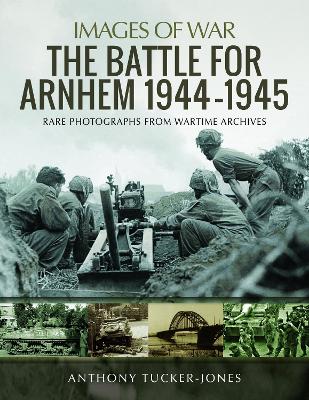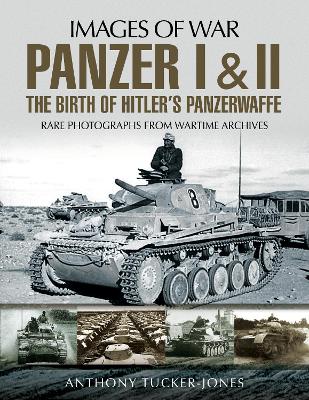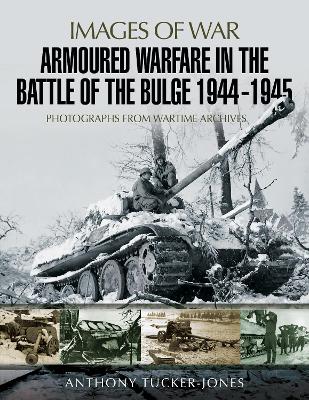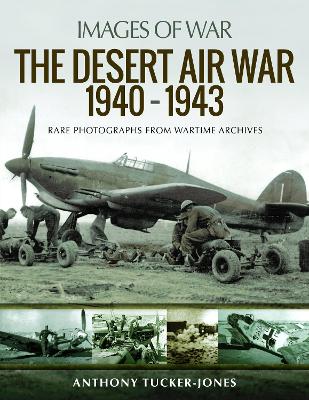Images of War
4 total works
Operation Market Garden, September 1944, the Netherlands. Three parachute drops and one armoured charge. The prize was the last bridge at Arnhem over the Neder Rijn. Taken intact it would provide the Allies with a back door into Germany - the famous Bridge Too Far'. This was one of the most audacious and imaginative operations of the war, and it failed, and Anthony Tucker-Jones's photographic history is a vivid introduction to it.
In a sequence of almost 200 archive photographs accompanied by a detailed narrative he describes the landing of British and American parachutists and glider troops. At the same time British tanks spearheaded a sixty-mile dash along Hell's Highway' to link up with the lightly armed and heavily outnumbered airborne forces.
Most books about the resulting battle concentrate on the struggle at Arnhem and the heroism of the British 1st Airborne Division. This book puts that episode in its wider context. In particular it focuses on the efforts of the US 101st and 82nd airborne divisions to hold off counterattacks by German battlegroups during the tanks' advance.
The photographs give a dramatic insight into all sides of a remarkable but ill-fated operation which has fascinated historians and been the subject of controversy ever since. They also portray, as only photographs can, the men who were involved and the places and conditions in which the fighting took place.
In a sequence of almost 200 archive photographs accompanied by a detailed narrative he describes the landing of British and American parachutists and glider troops. At the same time British tanks spearheaded a sixty-mile dash along Hell's Highway' to link up with the lightly armed and heavily outnumbered airborne forces.
Most books about the resulting battle concentrate on the struggle at Arnhem and the heroism of the British 1st Airborne Division. This book puts that episode in its wider context. In particular it focuses on the efforts of the US 101st and 82nd airborne divisions to hold off counterattacks by German battlegroups during the tanks' advance.
The photographs give a dramatic insight into all sides of a remarkable but ill-fated operation which has fascinated historians and been the subject of controversy ever since. They also portray, as only photographs can, the men who were involved and the places and conditions in which the fighting took place.
Panzer I and II: The Birth of Hitler's Panzerwaffe
by Tucker-Jones, Anthony
Published 26 September 2018
While the Panzer I and II are not as famous as the German tanks produced later in the Second World War, they played a vital role in Hitler's early blitzkrieg campaigns and in the Nazi rearmament programme pursued, at first in secret, by the Nazi regime during the 1930s. Anthony Tucker-Jones's photographic history of their design, development and wartime service is an ideal introduction to them.
Both panzers saw combat during the invasions of Poland and France, the Low Countries and Scandinavia during 1939-40. Although by the time the Wehrmacht invaded the Soviet Union in 1941, the Panzer I had been virtually phased out of service, in the form of self-propelled guns they continued to see combat well into 1943. The Panzer II was also phased out with the panzer regiments in late 1943, yet it remained in action on secondary fronts and, as the self-propelled Marder II anti-tank gun and Wespe artillery variant, it saw active service with the panzer and panzer grenadier divisions until the end of the war. The Panzer I and II were the precursors of the formidable range of medium and heavy tanks that followed-the Panzer III and IV and the Panther and Tiger-and this book is a fascinating record of them.
Both panzers saw combat during the invasions of Poland and France, the Low Countries and Scandinavia during 1939-40. Although by the time the Wehrmacht invaded the Soviet Union in 1941, the Panzer I had been virtually phased out of service, in the form of self-propelled guns they continued to see combat well into 1943. The Panzer II was also phased out with the panzer regiments in late 1943, yet it remained in action on secondary fronts and, as the self-propelled Marder II anti-tank gun and Wespe artillery variant, it saw active service with the panzer and panzer grenadier divisions until the end of the war. The Panzer I and II were the precursors of the formidable range of medium and heavy tanks that followed-the Panzer III and IV and the Panther and Tiger-and this book is a fascinating record of them.
Armoured Warfare in the Battle of the Bulge 1944-1945
by Tucker-Jones, Anthony
Published 2 October 2018
The Battle of the Bulge took the Allied armies by surprise in 1944\. It was a result of the extraordinary recovery of Hitler's panzer divisions following crushing defeats on the Eastern and Western fronts. In a daring offensive he hoped his panzers would unhinge the American and British push on the Rhine by charging through the Schnee Eifel, thereby prolonging the war. The consequence was one of the best-known battles of the entire conflict, and Anthony Tucker-Jones's photographic history is the ideal introduction to it. The story is told through a sequence of revealing contemporary photographs and a concise text. They give a sharp insight into the planning and decision-making, the armoured forces involved, the terrain and the appalling mid-winter conditions, the front-line fighting and the experience of the troops involved. The armoured battle, which was critical to the outcome, is the main focus. Through a massive tank offensive the Germans aimed to cut through the US 1st Army to Antwerp and Brussels, in the process trapping three Allied armies. The confusion and near collapse of the Americans as their defences were overrun is vividly recorded in the photographs, as is their resistance and recovery as the German spearheads were slowed, then stopped.
The war in air over North Africa and the Mediterranean during the Second World War has long been overshadowed by the battle on the ground. Between 1940 and 1943 Italy's Regia Aeronautica and then Germany's Luftwaffe waged a concerted aerial campaign against the British, yet apart from the bitter fight for Malta, this aspect of the conflict is rarely given the attention it deserves. Anthony Tucker-Jones, in this vivid photographic history, provides a fascinating introduction to it.
The wartime photographs, and the concise text, cover the entire course of the struggle in the air. The Regia Aeronautica at first met weak British opposition when Mussolini launched his ill-advised offensive against British-controlled Egypt, but the obsolete Italian aircraft proved to be no match for the Allied fighters once the strength of the Royal Air Force built up. Then, when Hitler stepped in to help his hapless ally, the aerial struggle intensified, and the air forces of both sides were locked in deadly combat in the skies over Egypt, Libya, the Mediterranean and Tunisia.
The wide range of Italian, British, German and American aircraft involved, the air and ground crews from all sides, and the conditions in which they operated and fought are all shown in this varied selection of photographs.
The wartime photographs, and the concise text, cover the entire course of the struggle in the air. The Regia Aeronautica at first met weak British opposition when Mussolini launched his ill-advised offensive against British-controlled Egypt, but the obsolete Italian aircraft proved to be no match for the Allied fighters once the strength of the Royal Air Force built up. Then, when Hitler stepped in to help his hapless ally, the aerial struggle intensified, and the air forces of both sides were locked in deadly combat in the skies over Egypt, Libya, the Mediterranean and Tunisia.
The wide range of Italian, British, German and American aircraft involved, the air and ground crews from all sides, and the conditions in which they operated and fought are all shown in this varied selection of photographs.



